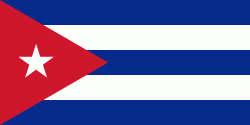San Miguel del Padrón (San Miguel del Padrón)
San Miguel del Padrón is one of the 15 municipalities/boroughs (municipios in Spanish) and one of the 4 subdivisions into which the city of Havana, Cuba is divided. It is on Havana's south-eastern outskirts, stretching from Ciudad Mar to Diezmero and from Reparto Mañana to Caballo Blanco.
This vast demographic area was unpopulated in the late 1940s, with small pockets of wealthy and land owners. It became heavily populated during the early 1960s with the emergence of Corea (name given to a stretch of terrain clandestinely occupied by the homeless after being evicted from the main city areas) and new houses along the main street (Calzada de San Miguel). By the mid 1960s the town became administratively adjacent to Guanabacoa.
San Miguel has been notorious for musicians, professional dancers and afro Cuban religious practitioners (Santería, Lukumi, Palo). During the early 1970s it was judicially declared one of the most troublesome towns in Havana due to a high degree of black market goods and comestibles.
Within San Miguel del Padron the municipality of Veracruz is home to a significant part of the town's population. The neighborhood consist mostly of old deteriorated apartment buildings predating 1970. The primary school is Heroes de Yaguajay, there is a baseball field and a farmers market. Electrical power and water are disconnected often in efforts to save for the Cuban revolution. Hunger and poverty is a way of life that the citizens have to become acclimated to.
This vast demographic area was unpopulated in the late 1940s, with small pockets of wealthy and land owners. It became heavily populated during the early 1960s with the emergence of Corea (name given to a stretch of terrain clandestinely occupied by the homeless after being evicted from the main city areas) and new houses along the main street (Calzada de San Miguel). By the mid 1960s the town became administratively adjacent to Guanabacoa.
San Miguel has been notorious for musicians, professional dancers and afro Cuban religious practitioners (Santería, Lukumi, Palo). During the early 1970s it was judicially declared one of the most troublesome towns in Havana due to a high degree of black market goods and comestibles.
Within San Miguel del Padron the municipality of Veracruz is home to a significant part of the town's population. The neighborhood consist mostly of old deteriorated apartment buildings predating 1970. The primary school is Heroes de Yaguajay, there is a baseball field and a farmers market. Electrical power and water are disconnected often in efforts to save for the Cuban revolution. Hunger and poverty is a way of life that the citizens have to become acclimated to.
Map - San Miguel del Padrón (San Miguel del Padrón)
Map
Country - Cuba
 |
 |
| Flag of Cuba | |
The territory that is now Cuba was inhabited by the Ciboney people from the 4th millennium BC with the Guanahatabey and Taíno peoples until Spanish colonization in the 15th century. From the 15th century, it was a colony of Spain, and slavery was abolished in 1886, remaining a Spanish colony until the Spanish–American War of 1898, when Cuba was occupied by the United States and gained independence in 1902. In 1940, Cuba implemented a new constitution, but mounting political unrest culminated in a coup in 1952 and the subsequent dictatorship of Fulgencio Batista, which was later overthrown in January 1959 by the 26th of July Movement during the Cuban Revolution, which afterwards established communist rule under the leadership of Fidel Castro. The country was a point of contention during the Cold War between the Soviet Union and the United States, and a nuclear war nearly broke out during the Cuban Missile Crisis of 1962. Following the collapse of the Soviet Union, Cuba faced a severe economic downturn in the 1990s, known as the Special Period. In 2008, Fidel Castro resigned after 49 years of leadership of Cuba and was replaced by his brother Raúl Castro.
Currency / Language
| ISO | Currency | Symbol | Significant figures |
|---|---|---|---|
| CUC | Cuban convertible peso | $ | 2 |
| CUP | Cuban peso | $ | 2 |
| ISO | Language |
|---|---|
| ES | Spanish language |















